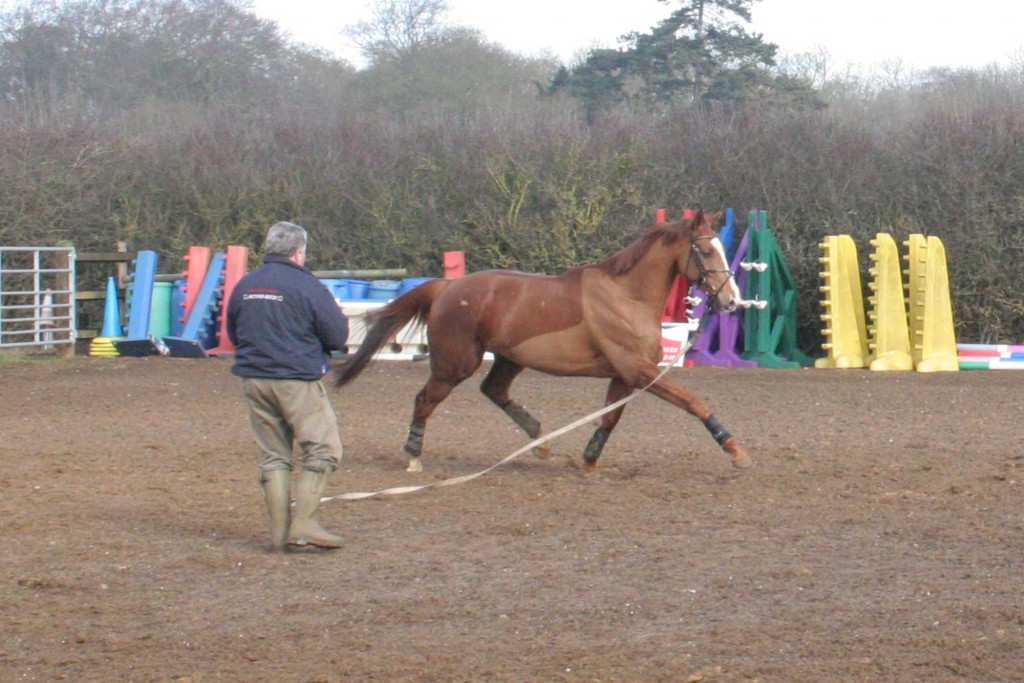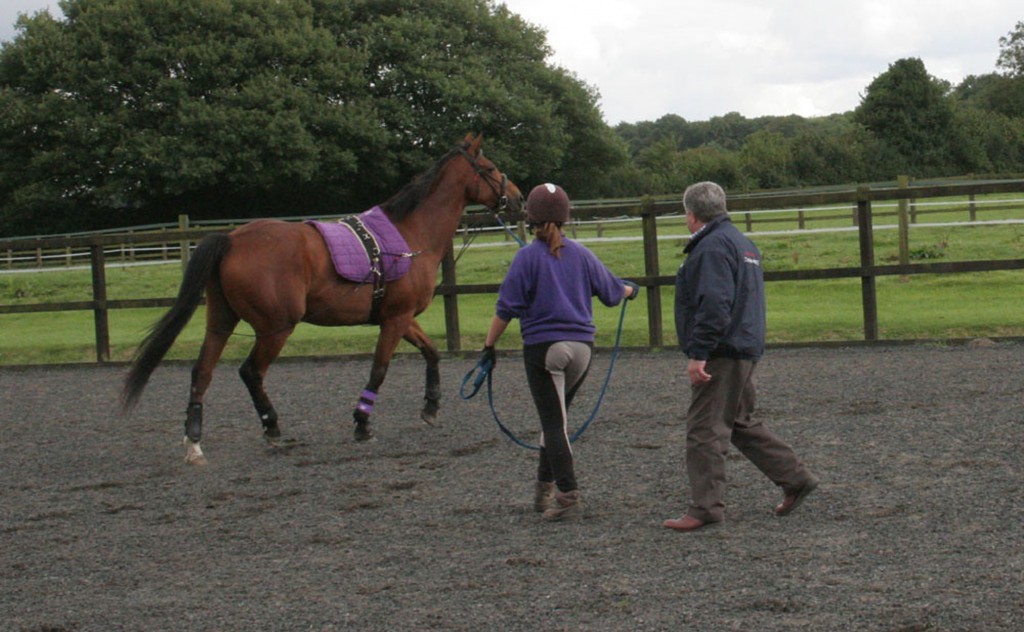In the sixth part of ‘Ground Training’, Fred and Rowena Cook (of Equine Management and Training) address the issues most people face when single line lunging a racehorse out of training.
More often than not, racehorse horses are lunged in a pen or small enclosure, so when presented with the open space of an arena they can be rather lively or seemingly naughty.
Lunging difficulties are usually due to unclear communication, poor positioning or the process not being started in the best manner. In the main, most of the common single lunge issues resolve once double lunge work commences as the second line affords much greater control and corrections to be carried out as under saddle. However, not everyone is comfortable or confident working with two lines so here are a few tips when things are not going right. Try and anticipate your horse’s moves so that you can remain one step ahead of him.
Remember that working on a circle is hard for any horse, let alone one who has not really encountered it before, so allow time for muscles to build up – do not expect too much too soon.
These two suggestions are unconventional, but work:
Or:

Note Fred’s stance – an easy hold of the lunge line and positioned mid-way along the horse’s length so that he can keep forward momentum and readily move towards to the shoulder to steady the horse or stop him turning in, or further towards to quarters if the horse tries to drop back. Even with a loose lunge line control can still be maintained by your body positioning and language. Do not worry at this stage how the horse is positioning his body, it is control you are after – refinement can come later on.
Some horses will readily tear off, snatching the line out of your hand the moment the lunge rein is let out. This is a habit developed as a consequence of poor handling when lunging was initially taught and/or a fright of some sort.
Often horses will not stay out on the length of lunge line given to them, preferring to cut in and then invariably rushing about – often in trot, but more usually in canter:
This habit often occurs when the trainer is a little lazy on rein changes, etc. and tends to “reel” the horse in. Follow the same steps as above, but also:
This usually occurs when the trainer is not in control, the horse is not paying any attention and is going too fast, or rather obviously, when the horse is feeling happy and full of himself.
Unbalanced or young horses will usually trot around with their heads inclined to the outside. With correct control from the trainer, the horse can be gradually asked to straighten and then finally incline slightly to the inside as his balance and suppleness improves.
This is the typical reaction of a horse that is not balanced; it is easier to canter than stay in trot as trotting is harder work. It is a case of repetition – keeping correcting him and bringing him back to trot.
When you get some good trot work reward your horse by bringing back to walk; then trot on again. Working on a circle is hard work for a horse so by cantering he is easing himself.
A little head-tossing in the early days is acceptable as it is usually a sign of anxiety whilst the horse is working out what is required of him (remember, this form of training is new to him).
However if he persists:
The horse has to learn to accept the bit so having eliminated the above:
The horse that has his head up is a hollow horse which is a tense horse. A hollow outline is an uncomfortable outline and needs correcting quickly and the horse encouraged to work out that actually it is way more comfortable to work with a lowered head/neck.
This is because the horse is tight or stiff in the outside neck and/or abdominal muscles to they need suppling and stretching
Throughout the entirety of training, we routinely talk here about the ‘swinging back’, a back which is supple as a result of lifted abdominal muscles and hind legs coming under the body. Horses are often seen that have indeed adopted a rounder outline but it can readily be seen that they look stiff and stilted in their action, somewhat rigid. This is because the back is not soft and swinging. Lack of swing is not the preserve of the ex-racehorse.
It is harder for the thoroughbred to achieve ‘swing as by their very breeding, they are designed to run, not perform dressage movements, but that doesn’t mean to say that they can’t develop swing. Also many former racehorses will have incurred a trauma to the back/pelvic region which, although having no knock-on effect on their racing, can do so later on in life when schooling as a riding horse takes over. Thus they need more time and a considerable amount of suppling work.
Getting a horse to step under more is initially achieved by encouraging him to stretch – the nose reaching forward and downward as if he was about to start grazing. A fully stretched neck activates the muscles of the abdomen and back and allows the hind legs to step under, further activating the muscles of the hindquarters and stretching the hamstrings. As the back supples, the horse naturally lifts through the withers arching his neck forwards (reaching into the bit) with is poll the highest point. If the poll is not the highest point a horse can’t step under correctly; the overbent horse (where the nose is brought into the chest) is unable to take weight behind as he doesn’t build the correct muscles.
When training a horse it is the abdominal, dorsal and lumber muscles which need strengthening first as the horse needs a strong central core to support his back. When these muscles start to take shape, the horse will naturally reach forwards, as a result of which he has to bring his hind legs under in order to maintain his balance. The horse that begins to take weight behind lifts his forehand with the neck raised and arched (from the withers). As the horse works more consistently through his back and steps under with increased activity and flexion in the hocks this forms the basis for collection – where a horse lowers his croup as if appearing to “sit” i.e. his centre of gravity has moved back and he is truly taking weight behind.

Fred guides a young student in the art of lunge work. Here he demonstrates encouraging the horse to move forward without the use of a lunge whip by offering his hand and positioning himself behind the horse’s mid-line.
Fred and Rowena Cook
In the next section of this in-depth series, Fred and Rowena will cover double lunge and simple long reining work.
Thoroughbred Training Consultants – Equine Management and Training
Inc Rehoming Racehorses – A Life After Racing
RoR Approved Racehorse Retrainers
Retraining Consultants to Greatwood Charity
UK Agents: Ardall Equine & Rider Safety System
Authors: “Re-Educating Racehorses – A Life After Racing”
To find your own ex-racehorse, please visit Source an Ex-Racehorse